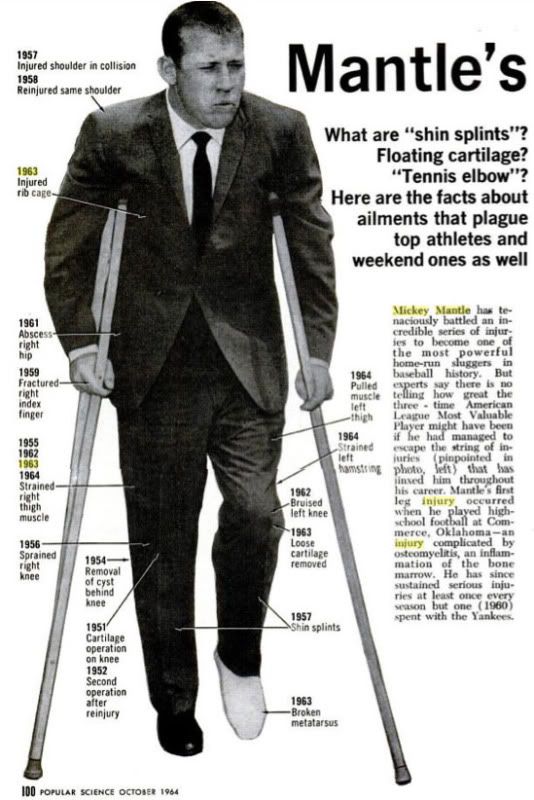an excerpt from sports illustrated
Mickey Mantle came out of the tunnel from the New York Yankees' dressing room and walked along the dugout in front of the crowded bench. There was no place to sit, and at the far end he put a foot up on the step, rested his arm on his knee and looked out at the rain. Another Yankee player said, grinning, "You'd think one of you writers would get up and let a $100,000 ballplayer sit down."Mick wouldn't play again until August. He only played about 90 games that year.
The rain finally slowed and stopped, and the game started, more than an hour late. The night before, when Baltimore had beaten New York 3-1 to take over the league lead, Mantle had hit a home run, two outfield flies and a single to center and had been on third base, waiting to score, when the game ended. Now, this wet night, he singled to right in the second inning and walked in the fourth. In the sixth he doubled to left and scored when Roger Maris hit a home run to put New York ahead 3-2.
Then in the last half of the sixth inning Brooks Robinson of Baltimore hit a ball high and far toward the center-field fence. Mantle turned and raced back for it, running at full speed in his choppy, high-stepping sprinter's stride. He looked up over his right shoulder as he ran, and as he neared the ball he lifted his glove to catch it. But the point of juxtaposition of glove and ball that Mantle anticipated was theoretical—it lay a few feet beyond the seven-foot-high wire fence bounding the outfield. There was no cinder warning track in front of the fence, as in most ball parks, and as the ball went over for a home run Mantle ran into the fence. His left foot hit on the downward stroke of its stride, and his spikes caught in the wire mesh. The front part of his foot was bent violently up and back. The momentum of his run smashed him up against the fence and he seemed to hang there for an instant. Then he crumpled to the ground.
Roger Maris ran over to him and Bobby Richardson ran out and the players in the Yankee bullpen in right field streamed along the fence toward him. Other players ran out and joined the uniformed throng massed incongruously in the deepest part of the outfield. A Yankee came out of the tangle and signaled to the dugout, making a wheelbarrow-pushing motion with his hands. "They want a stretcher," said a writer in the press box.
The stretcher went out and disappeared into the crowd. When it appeared again, it bore Mantle. He lay on his side, half sitting up, supporting himself on his right elbow, somber and quiet. "He looks like a warrior being carried on his shield," said the man in the press box.
Beneath the stands in the corridors behind the Yankee dressing room the sportswriters were held at bay by polite but adamant guards. The writers argued. "You can't go in," a guard said flatly, and the writers waited. They saw New York players come back through the tunnel from the dugout—the Baltimore half of the inning had ended—and go into the dressing room: Ralph Terry, Bobby Richardson, Roger Maris, others. They looked tired. They were in the dressing room with Mantle for only a moment or two, and then they filed back along the tunnel to the dugout. The game went on.
Beneath the stands a door opened and a wheeled stretcher rolled out. Mantle lay on it, flat on his back now, a blanket covering him. He was rolled quickly to an ambulance waiting in the dark at the curb outside the stadium. The stretcher was lifted and slid in. Mantle stared up at the dark ceiling of the ambulance, his face expressionless. Then he lifted his hands and pressed them against his cheeks and held them there for a long moment. The ambulance drove away.

On August 4, in his first at-bat after being out for two months, he hit a pinch-hit homer in the 7th to tie the score against Baltimore 10-10. Yanks won it in the 10th on Berra's sac fly.
ReplyDeletethis is an amazing, gorgeous, simple and easy honest video clip of your strategy. I am this type of fan of your function! I would require a bite associated with sweet off a new tree each day.
ReplyDelete